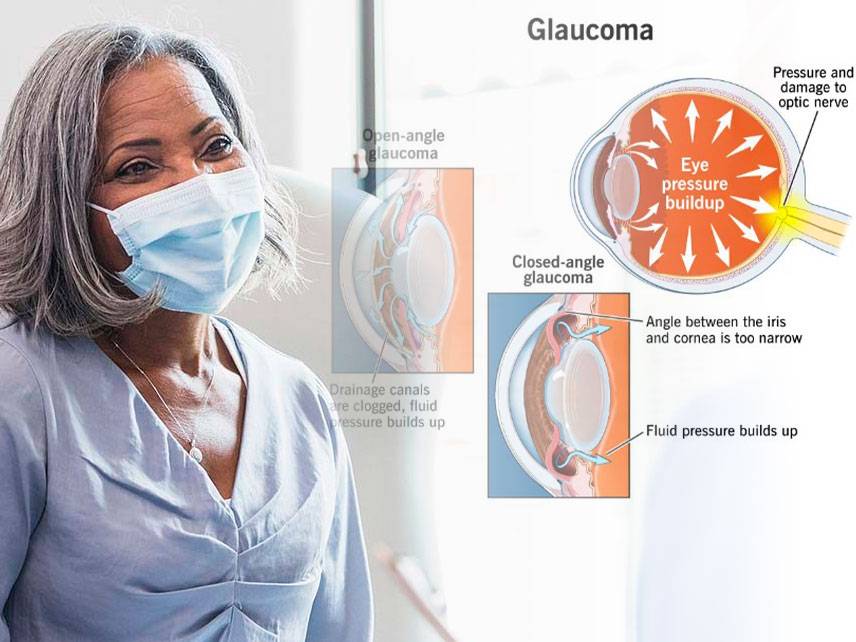Glaucoma is a group of eye disorders that damage the optic nerve, which is vital to vision. The optic nerve carries images from your eyes to your brain, where they are interpreted.
Glaucoma is often associated with a buildup of pressure inside the eye. This increased pressure, called intraocular pressure, can damage the optic nerve.
Glaucoma is the second-leading cause of blindness in the United States. According to the National Eye Institute, more than 3 million Americans have glaucoma, but only half of them know it.
There are two main types of glaucoma:
-
Open-angle glaucoma is the most common type. It develops slowly and painlessly.
-
Angle-closure glaucoma is less common but more serious. It can develop rapidly and cause severe eye pain, headaches, and nausea.
Signs and symptoms
Glaucoma has no early warning signs or symptoms. The best way to protect your vision is to have regular comprehensive eye exams.
During a comprehensive eye exam, your eye care professional will:
-
measure your intraocular pressure
-
examine the health of your optic nerve
-
check for any signs of damage to your retina
-
dilate your pupils to examine the inside of your eyes
If you have open-angle glaucoma, you may not notice any changes in your vision until the disease is quite advanced.
Angle-closure glaucoma can come on suddenly. Signs and symptoms include:
-
severe eye pain
-
nausea and vomiting
-
a headache
-
blurry vision
-
halos around lights
-
redness in the eye
If you experience any of these symptoms, call your eye care professional or go to the emergency room immediately.
Causes
Open-angle glaucoma
Most cases of open-angle glaucoma are caused by a gradual buildup of fluid in the front part of the eye. This fluid is called aqueous humor.
Aqueous humor is produced by the ciliary body, a ring of tissue around the edge of the iris. The ciliary body also regulates the amount of aqueous humor that drains out of the eye.
If the drainage system becomes blocked, the aqueous humor can build up, causing intraocular pressure to increase.
Angle-closure glaucoma
Angle-closure glaucoma occurs when the iris bulges forward, narrowing the angle between the iris and the cornea. This narrowing prevents the aqueous humor from draining properly, causing intraocular pressure to increase.
Risk factors
There are several risk factors for glaucoma, including:
-
age - the risk of glaucoma increases as you get older
-
family history - if you have a family member with glaucoma, you're more likely to develop the disease
-
race - African Americans are at a higher risk for glaucoma than other groups
-
medical conditions - diabetes, high blood pressure, and other conditions can increase your risk for glaucoma
-
eye injury - a serious eye injury can lead to glaucoma
Prevention
There is no sure way to prevent glaucoma. The best way to protect your vision is to have regular comprehensive eye exams.
If you're at a high risk for glaucoma, your eye care professional may recommend more frequent exams.
Diagnosis
Glaucoma is usually diagnosed during a comprehensive eye exam.
During the exam, your eye care professional will:
-
measure your intraocular pressure
-
examine the health of your optic nerve
-
check for any signs of damage to your retina
-
dilate your pupils to examine the inside of your eyes
If you have open-angle glaucoma, you may not notice any changes in your vision until the disease is quite advanced.
Angle-closure glaucoma can come on suddenly.
Signs and symptoms include:
-
severe eye pain
-
nausea and vomiting
-
a headache
-
blurry vision
-
halos around lights
-
redness in the eye
If you experience any of these symptoms, call your eye care professional or go to the emergency room immediately.
Treatment
Glaucoma is a chronic condition that cannot be cured. But it can be controlled.
The goal of treatment is to prevent or slow the progression of the disease and preserve your vision.
Treatment options include:
-
eye drops - these can help reduce intraocular pressure by decreasing the amount of aqueous humor produced or by increasing the amount that drains out of the eye
-
medications - oral medications can be used to treat glaucoma
-
surgery - surgery can be used to improve the drainage of aqueous humor from the eye
Coping and support
If you have glaucoma, it's important to follow your treatment plan. This will help to prevent or slow the progression of the disease and preserve your vision.
Your eye care professional can help you create a plan that's right for you.
It's also important to see your eye care professional regularly for follow-up exams.
If you have trouble following your treatment plan, there are resources that can help. The Glaucoma Foundation and the American Academy of Ophthalmology can provide information and support.
Complications
If glaucoma is not treated, it can lead to blindness.
Living with glaucoma
Living with glaucoma can be a difficult and frustrating experience. Glaucoma affects the peripheral vision first, and while there is no cure, treatments can help control the progression of the condition. People who live with glaucoma must make lifestyle changes to manage the disease, such as avoiding activities that may increase eye pressure, wearing protective eyewear and taking medications as prescribed. While living with glaucoma may not be easy, it is possible to manage the condition and preserve your vision.





